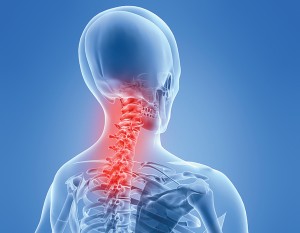By Robert J. Ycaza, MD –


Acute and Chronic Neck Pain
Neck pain is generally categorized as acute or chronic. Acute neck pain often results from sudden trauma or a muscle or tendon strain within the neck. It heals in a relatively short amount of time, lasting typically less than three months. Chronic neck pain typically lasts more than three months and may be indicative of an underlying problem that requires more extensive treatment measures.
Referred Neck Pain
One can experience referred neck pain when adjacent structures are affected, including: bursitis of the shoulder joint, rotator cuff injuries, tendonitis, or trauma to the clavicle or shoulder. Neck pain can present in different forms, including: dull, burning, crampy, sharp, shocklike, or stabbing pain. It can lead to a stiff neck or shoulder and loss of range of motion. Psychological conditions or every day life stress and tension can be a causative factor in the onset, recurrent or permanence of neck pain as well. Headaches may also be the result of neck pain, from common tension headaches to severe migraine attacks.
Location of Symptoms Provides Important Clues to Cause of Pain
The location of each symptom is important because it can provide clues to the cause of your pain. Other possible symptoms include:
Weakness: More commonly happens in the upper extremities accompanying neck pain. It can be the result of the inability or reluctance to move because of pain or inflammation, or can be the result of impending neurological damage due to pressure over the spinal cord or adjacent nerves.
Numbness: Nerve inflammatory reactions can be manifested in many different ways, causing a burning or tingling sensation, a loss of sensation, or an altered sensation similar to having your arm “fall asleep.”
Coolness: A cool arm or hand suggests that the arteries, veins, or both have been injured or blocked., which may mean that not enough blood is getting into the arm.
Swelling: This may be generalized to the whole arm or may be localized over the involved structures. Muscle spasms or tightness may simulate actual swelling. Dislocation or deformity may cause a swollen appearance or a sunken area.
Deformity: A deformity may be present if you have a fracture or a dislocation. Certain ligament tears can cause an abnormal positioning of the bony structures.
Conservative Treatment Options
Acute neck pain can oftentimes be treated conservatively with pain medications, heat/ice therapy, and other non-surgical options. Non-steroidal anti-inflammatory medications, such as Motrin or ibuprofen, can be helpful to decrease any inflammatory component and decrease the pain within that area of the neck. Although Tylenol does not have an anti-inflammatory component, it can also block some of the pain you experience.
Other conservative treatment options include massage, chiropractic and physical therapy. With stiff necks, we often have muscle knots (muscle spasms) and massage can also help break up those spasms providing some relief. Chiropractic manipulations can help increase the range of motion, decrease the pain, relax the muscles and sometimes realign certain structures which may be malaligned. Physical therapy is often used in the recovery process of neck pain, teaching the patient what activities to do, what not to do, as well as instruction on proper posture. Poor posture can be associated with acute neck pain and having better posture can help prevent this in the future.
When to Seek Medical Attention for Acute Neck Pain
It is important to seek medical attention if your acute neck pain gets progressively worse and does not respond to any of the more conservative treatment measures.
When pain radiates down the arm, and possibly into the hands and fingers, sometimes accompanied by numbness or tingling in the arms and/or hands, this could be a sign that the nerves in the neck or spinal cord are affected, caused by a cervical herniated disc or foraminal stenosis pinching a nerve in the neck. Symptoms may start suddenly or progress over time. You should seek medical attention immediately if you experience any of those symptoms or either of the following:
- Progressive neurological deficit (weakness in the arms or loss of feeling and coordination in the arms or legs) which could indicate nerve damage.
- Sustained or increasing pain and neurological deficits (as above) accompanied by a lack of appetite or unplanned weight loss, in which case a tumor or malignancy may be suspected.
Diagnosis and Treatment
A thorough history and physical examination will be conducted to establish a diagnosis. Diagnostic tests, X- rays, and an MRI of the neck are commonly used to identify changes in the spine which help determine treatment options. Applying local ice or heat, along with passive modalities, including ultrasound, electrical stimulation, iontophoresis, infrared light therapy, can be the initial approach for treatment. Therapeutic exercises can also be considered as a means of improving one’s condition.
If such measures fail, epidural injections and facet (joint) denervations are some of the invasive treatments, short of surgery, that can be used for chronic neck pain.
Get Rid of that Pain in the Neck!
If you or a family member is suffering from acute or chronic neck pain, a comprehensive evaluation can be performed and get you on the way to getting rid of that pain in the neck!
To schedule an appointment, please call Bradenton Pain & Wellness Center at 941-803-8395 or visit us online at www.drycaza.com.
Robert J. Ycaza, M.D.
CALL: 941-803-8395
www.drycaza.com
 Southwest Florida's Health and Wellness Magazine Health and Wellness Articles
Southwest Florida's Health and Wellness Magazine Health and Wellness Articles

